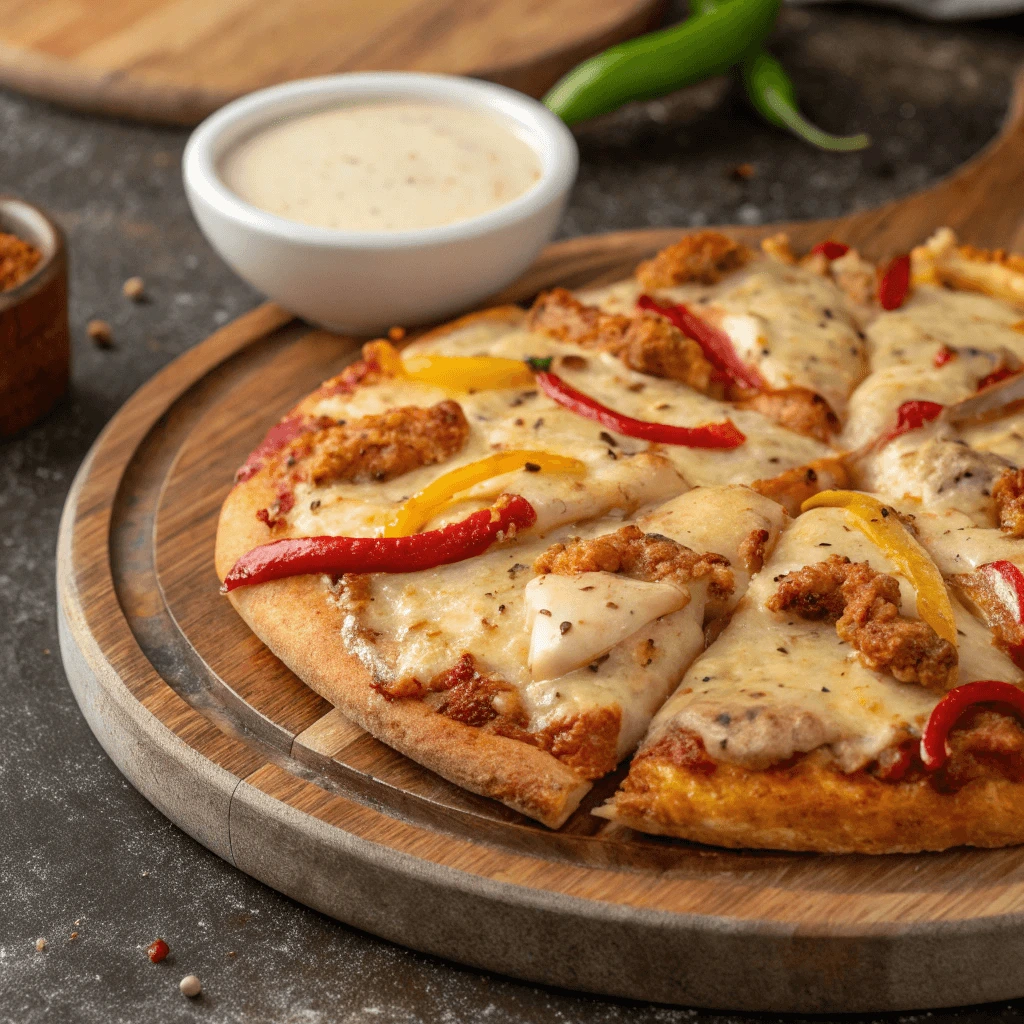When it comes to pizza, size matters—especially when you’re craving the perfect serving for one or a small group. 10-inch pizza offer the ideal balance of personal indulgence and shareable fun. Whether you’re hosting a cozy gathering, making a quick dinner, or experimenting with new toppings, a 10-inch pizza gives you the flexibility to create something delicious for any occasion. From classic favorites like pepperoni and Margherita to creative gourmet options, this versatile size allows for endless flavor combinations. In this post, we’ll explore some of the best 10-inch pizza recipes, perfect for everything from casual weeknight meals to special celebrations. Get ready to elevate your pizza game with these fun, easy-to-make ideas that everyone will love!
Why 10-Inch Pizzas Are Perfect for Any Meal
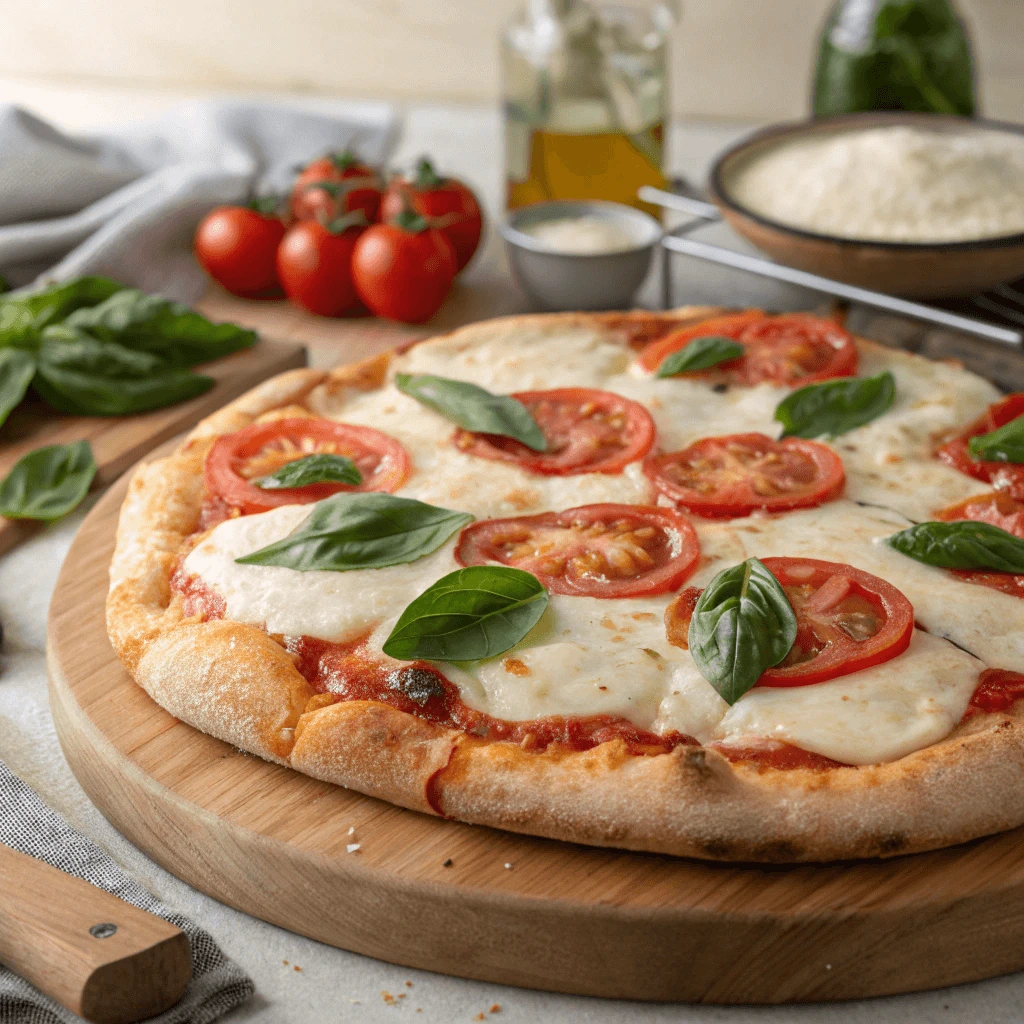
Ideal Size for Personal or Shared Meals
Perfect for a Satisfying Personal Portion
A 10-inch pizza offers just the right amount of food for one person with a big appetite. Unlike smaller personal pizzas that may leave you wanting more, this size provides a hearty meal while still feeling manageable. It also fits easily on standard plates and baking trays, making it convenient for both cooking and serving. You can top it with your favorite veggies, grilled chicken, or even a plant-based cheese and still have enough room to experiment without overloading the crust.
Great for Two to Share
If you’re dining with someone else, a 10-inch pizza makes an excellent shared meal—especially when paired with a fresh salad or side dish. Couples often choose this size for lunch or dinner when they want something flavorful but not too heavy. For lighter eaters, half a pizza may be just enough, and leftovers are easy to save for later.
Smart Option for Events and Variety
This size also works well when you’re serving a group and want to offer multiple flavor options. Instead of baking one large pizza for everyone, consider preparing several 10-inch pizzas with different toppings—such as margherita, spinach and mushroom, or spicy grilled chicken. Guests can try a slice of each, creating a more exciting and customizable meal experience. Plus, smaller pizzas bake faster and more evenly, helping you get hot, crispy crusts every time.
Great for Portion Control and Customization
Helps You Manage Serving Sizes Easily
A 10-inch pizza naturally supports healthier eating habits by setting a clear limit on portions. Whether you’re tracking calories, managing carbs, or simply avoiding overeating, this size makes it easier to stay on target. Unlike larger pizzas, where slices often vary in size and you’re tempted to grab “just one more,” a 10-inch pizza gives you predictable portions—usually six slices. This allows you to plan meals more effectively without sacrificing enjoyment.
Ideal for Individual Dietary Needs
When you prepare 10-inch pizzas at home, you can cater to individual dietary preferences with ease. One person may want dairy-free cheese and roasted vegetables, while another prefers extra protein with grilled chicken and olives. Instead of compromising on toppings or making one large pizza that tries to please everyone, you can create several smaller pizzas tailored to each person’s taste and nutritional goals. This also helps reduce food waste, since people are more likely to finish what they actually enjoy.
Encourages Creative Cooking and Toppings
Customization goes beyond health—it’s also about creativity. A 10-inch pizza gives home cooks and food lovers the perfect canvas to try new sauces, toppings, and combinations. Want to experiment with garlic-infused olive oil, vegan feta, or fresh arugula? This personal size lets you explore without the pressure of getting it perfect for a crowd. Even kids can join in, making their own pizzas with fun and colorful toppings that encourage better eating habits.
Versatile Enough for Any Occasion
Perfect for Casual Weeknight Dinners
A 10-inch pizza fits effortlessly into busy weeknights. You can prepare it quickly, using simple ingredients you already have in your kitchen. Whether it’s a classic margherita or a veggie-loaded option with mushrooms, bell peppers, and spinach, this pizza size offers the right amount for one or two people without leftovers going to waste. Pair it with a side salad for a balanced meal that comes together in under 30 minutes.
A Crowd-Pleaser at Parties and Gatherings
If you’re hosting a game night, birthday party, or casual get-together, serving multiple 10-inch pizzas allows guests to choose from a variety of flavors. It’s easier to accommodate different dietary needs when each pizza has its own theme—one might be topped with grilled chicken and pesto, another with olives and feta, and a third with roasted vegetables and vegan cheese. This variety adds fun and flexibility to your menu.
Great for Special Occasions or Celebrations
While simple enough for everyday meals, a 10-inch pizza can also feel special. Dress it up with gourmet toppings like sun-dried tomatoes, arugula, and a drizzle of truffle oil for a date night or holiday dinner. Use artisan crusts or add a stuffed crust edge to elevate the presentation. You can even bake a dessert pizza—try a cinnamon sugar base with fruit and a drizzle of icing for a sweet finish.
How to Make the Perfect 10-Inch Pizza Dough
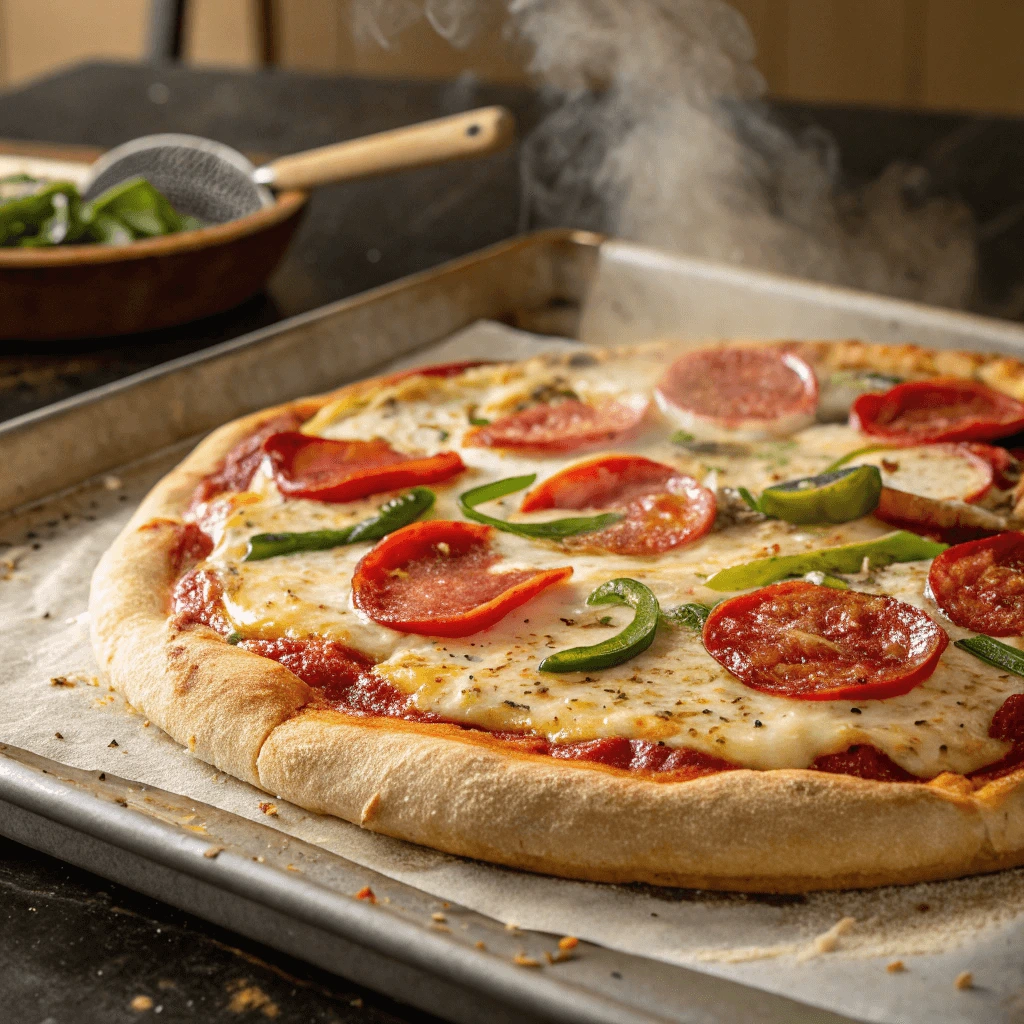
Basic Dough Recipe for Beginners
Learning to make pizza dough from scratch can feel intimidating, but it doesn’t have to be. This beginner-friendly recipe simplifies the process and uses common ingredients. With the right steps, even first-time bakers can create a soft, stretchy dough perfect for a 10-inch pizza.
Ingredients You’ll Need
To get started, gather these basic ingredients:
- 2 cups (250g) all-purpose flour
- ¾ cup (180ml) warm water (about 110°F or 43°C)
- 1 teaspoon active dry yeast
- 1 teaspoon sugar
- 1 tablespoon olive oil
- 1 teaspoon salt
Each ingredient plays a role—yeast helps the dough rise, sugar activates the yeast, salt enhances flavor, and olive oil improves texture.
Mixing and Kneading the Dough
Start by dissolving the yeast and sugar in warm water. Let it sit for about 5–10 minutes until it becomes foamy. This step confirms the yeast is active. Next, add the flour and salt to a mixing bowl. Gradually pour in the yeast mixture and olive oil while stirring.
Once a rough dough forms, knead it by hand or with a stand mixer for 8–10 minutes. The dough should become smooth and elastic. If it feels too sticky, sprinkle in a little more flour. If it’s too dry, add a tablespoon of water at a time.
Letting the Dough Rise
Form the kneaded dough into a ball and place it in a lightly oiled bowl. Cover it with a damp towel or plastic wrap and let it rise in a warm spot for 1 to 1.5 hours. The dough should double in size. After rising, punch it down gently to release air bubbles. Now it’s ready to roll out and top for your 10-inch pizza.
Gluten-Free and Whole Wheat Variations
If you’re looking for healthier or more inclusive options, gluten-free and whole wheat pizza dough are excellent choices. Each offers unique flavors and textures, catering to different dietary needs.
Gluten-Free Pizza Dough
For gluten-free diets, using a blend of gluten-free flours is essential. Here’s how to make it:
- Ingredients: Gluten-free all-purpose flour, xanthan gum (optional), yeast, sugar, olive oil, and warm water.
- Instructions: Combine dry ingredients, mix with activated yeast and water, knead, and let rise. It’s stickier than regular dough, so handle carefully.
Tip: Use a pizza stone for a crispier crust.
Whole Wheat Pizza Dough
Whole wheat dough provides more fiber and a nutty flavor. It’s perfect for a more wholesome pizza crust.
- Ingredients: Whole wheat flour, all-purpose flour, yeast, sugar, olive oil, and warm water.
- Instructions: Mix dry ingredients, combine with yeast mixture, knead, and let rise.
Tip: For a lighter dough, you can add a bit more olive oil.
Which One to Choose?
Both variations suit different needs. Gluten-free dough is ideal for those avoiding gluten, while whole wheat adds extra fiber and nutrients. Feel free to mix the two for a balanced pizza dough!
Tools You Need for Best Results
Making pizza dough is as much about the right tools as it is about the ingredients. With the proper equipment, you’ll get a consistent texture and perfect crust every time. Here are the must-have tools to ensure your dough comes out perfectly.
1. Mixing Bowl
A large mixing bowl is essential for combining your ingredients. Use a sturdy glass or stainless-steel bowl that can accommodate the dough as it rises. This bowl should have enough space for mixing and kneading without overflowing. A good bowl also helps when you need to cover the dough and let it proof, ensuring it has enough room to expand.
2. Dough Hook or Hand Mixer
Using a dough hook on a stand mixer will save you a lot of time and effort. It mixes and kneads the dough effectively, ensuring the right consistency. If you don’t have a stand mixer, you can knead the dough by hand, but a hand mixer with dough hooks can offer some assistance.
Tip: If kneading by hand, use a bit of flour to keep the dough from sticking to your hands or the work surface.
3. Rolling Pin or Your Hands
When rolling out your dough, you can use either a rolling pin or your hands. A rolling pin offers a more uniform thickness, which is essential for an even bake. If you prefer a more rustic look, using your hands will allow you to stretch and shape the dough without compressing the air inside it. If you go the rolling pin route, lightly flour it to avoid sticking.
4. Pizza Stone or Baking Sheet
For the best crust, a pizza stone is a must. It absorbs heat and distributes it evenly, creating a crispier crust. Preheat your pizza stone before placing the dough on it for an even bake. Alternatively, a baking sheet can work if you don’t have a pizza stone. Just make sure to line it with parchment paper to prevent sticking.
5. Pizza Peel or Spatula
A pizza peel helps you transfer your pizza to the oven with ease. This flat, paddle-like tool ensures you don’t ruin your dough while moving it. If you don’t have a pizza peel, you can use a large spatula or the back of a baking sheet as an alternative. Lightly dust it with flour to help slide the dough onto the pizza stone or sheet.
6. Timer and Thermometer
Monitoring your baking time and temperature is key to achieving the perfect pizza. A timer will help you avoid overcooking your crust. Additionally, an oven thermometer ensures your oven maintains the right temperature, as ovens can sometimes run hot or cold.
7. Pastry Brush (Optional)
For those who enjoy a flavorful, golden crust, a pastry brush is useful for applying olive oil or butter to the edges of your pizza before baking. This adds flavor and helps achieve that golden, crispy texture.
Delicious Vegetarian 10-Inch Pizza Ideas
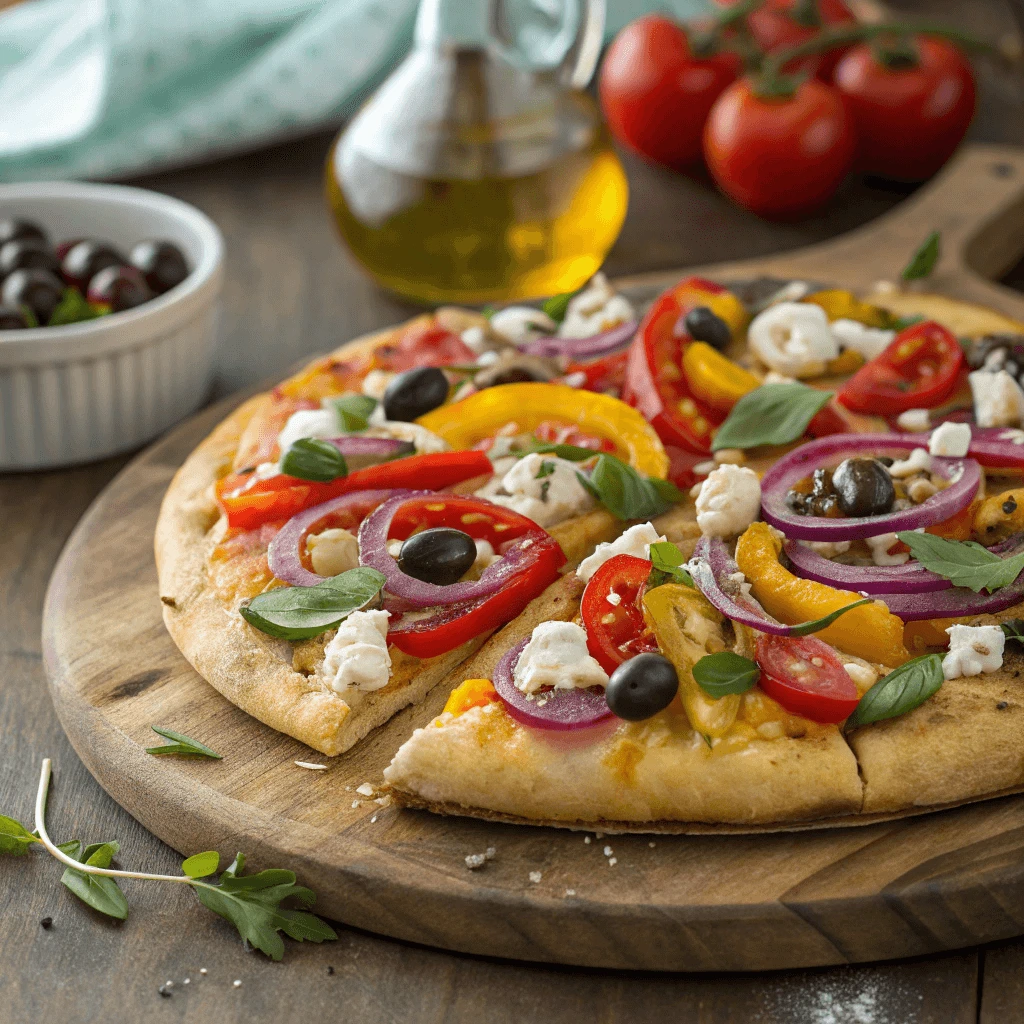
Margherita Pizza with Fresh Basil
Margherita pizza is a classic favorite, loved for its simplicity and fresh ingredients. With a base of homemade dough, rich tomato sauce, creamy mozzarella, and aromatic basil, it’s a true Italian treat.
1. Making the Tomato Sauce
For the best flavor, make your own tomato sauce:
- Use crushed tomatoes with a splash of olive oil, garlic, salt, and a pinch of sugar.
- Simmer for 10-15 minutes to thicken and enhance the flavors.
2. Choosing the Right Mozzarella
Fresh mozzarella is key to this pizza:
- Tear it into small chunks or slices for even distribution.
- Opt for whole milk or buffalo mozzarella for a creamy, smooth texture.
3. Assembling the Pizza
- Roll out the dough to about 10-12 inches.
- Spread the tomato sauce, leaving a small border for the crust.
- Add mozzarella evenly over the sauce.
4. Adding Fresh Basil
- Add basil before or after baking. Pre-baking infuses the flavor, while adding it after preserves its freshness.
5. Baking the Pizza
- Bake at 475-500°F (245-260°C) for 10-12 minutes.
- Ensure the crust is golden and the cheese is bubbling.
6. Serving
Let the pizza cool slightly before slicing. Top with more fresh basil and a drizzle of olive oil for extra flavor.
Mediterranean Veggie Pizza
Mediterranean veggie pizza combines fresh vegetables, herbs, and bold flavors for a light, satisfying meal. It’s perfect for those who want a veggie-packed pizza with vibrant colors and tastes.
1. Essential Veggies for the Pizza
The key to this pizza is choosing the right vegetables:
- Red onions: Add sweetness and a slight crunch.
- Bell peppers: Bring color and mild flavor.
- Olives: Provide a salty, briny punch.
- Tomatoes: Offer juiciness and freshness.
- Spinach or arugula: Adds a peppery kick.
These veggies work together to create a flavorful base.
2. Simple Sauce Options
For a Mediterranean flavor, use one of these sauces:
- Garlic-infused olive oil: Lightly sauté minced garlic in olive oil, then drizzle over the dough for a rich, subtle flavor.
- Tomato sauce: Simmer crushed tomatoes with garlic, basil, and oregano for a tangy, aromatic base.
3. Assembling the Pizza
- Spread the sauce: Evenly coat the dough with your choice of sauce.
- Layer the veggies: Place the vegetables over the sauce without overcrowding the pizza.
- Top with cheese: Sprinkle feta cheese for a creamy, tangy finish. For a dairy-free version, use vegan feta.
4. Baking the Pizza
Bake the pizza at 475°F (245°C) for 10-12 minutes, or until the crust is golden and the veggies are tender. After baking:
Finish with olive oil: Drizzle extra virgin olive oil for a smooth, rich touch.
Add fresh greens: Top with basil or arugula for a fresh burst of flavor.
Creamy Spinach and Mushroom Delight
This creamy spinach and mushroom pizza combines rich flavors with a velvety garlic cream sauce. It’s the perfect comfort dish, offering a vegetarian option with a balance of creamy and earthy tastes.
1. Creamy Garlic Sauce
Make the creamy garlic sauce by simmering heavy cream, butter, garlic, and salt. This creates a smooth base that complements the mushrooms and spinach. Spread it evenly over the dough for a rich, comforting foundation.
2. Sautéing Spinach and Mushrooms
Sauté sliced mushrooms in olive oil until golden brown, then wilt fresh spinach. This combo creates a hearty base of veggies with an earthy flavor that pairs perfectly with the creamy sauce.
3. Topping with Cheese
Top your pizza with mozzarella cheese for a smooth melt and Parmesan for extra flavor. If you like stronger cheese, try goat or blue cheese for a tangy finish.
4. Baking
Bake at 475°F (245°C) for 10-12 minutes, until the crust is golden and cheese is bubbling. Drizzle with olive oil and add fresh basil for extra flavor.
Tasty Chicken and Cheese Pizza Variations
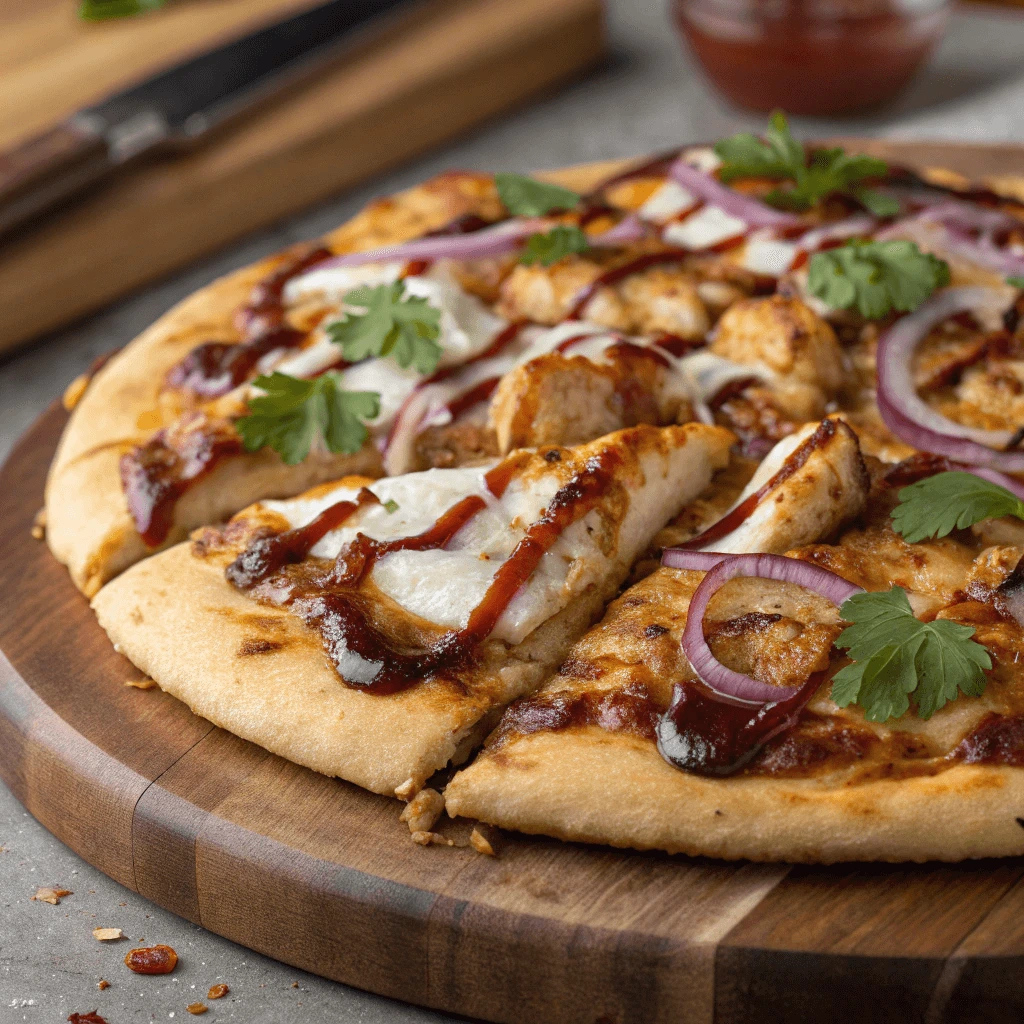
BBQ Chicken Pizza with Red Onions
BBQ chicken pizza is a fantastic blend of smoky, tangy, and sweet flavors. The tender chicken, paired with tangy barbecue sauce and sweet red onions, makes this pizza a standout choice for any meal.
1. Preparing the Chicken
Start by grilling or roasting chicken breast until it’s cooked and juicy. Season it simply with salt, pepper, and paprika. Once cooked, slice the chicken into thin strips to spread evenly over the pizza.
2. Making the BBQ Sauce
Choose your favorite barbecue sauce or make your own by mixing ketchup, brown sugar, vinegar, and mustard. Coat the chicken with the sauce to give it a rich, smoky flavor.
3. Assembling the Pizza
Spread a thin layer of barbecue sauce on the pizza dough and top it with mozzarella cheese. Add the BBQ chicken and red onion slices. The sweetness of the red onions balances perfectly with the tangy barbecue sauce.
4. Baking and Serving
Bake the pizza at 475°F (245°C) for 10-12 minutes, until the crust is golden and the cheese is bubbly. Garnish with fresh cilantro for a touch of freshness and serve hot.
Classic Chicken Alfredo Pizza
The Classic Chicken Alfredo Pizza brings together the creamy flavors of Alfredo pasta and a crispy pizza crust. It features a rich Alfredo sauce, tender chicken, and melted cheese, creating a delicious, comfort-filled meal.
1. Preparing the Chicken
Start with boneless, skinless chicken breasts. Season them with salt, pepper, and Italian herbs, then cook them by grilling, sautéing, or baking. Slice the cooked chicken into small pieces, ready to top the pizza.
2. Making the Alfredo Sauce
For the sauce, melt butter in a pan, then add heavy cream and Parmesan cheese. Stir until the sauce thickens and becomes creamy. This will serve as the base sauce instead of the usual tomato sauce.
3. Assembling the Pizza
Roll out your dough and spread the Alfredo sauce over it. Add a generous layer of mozzarella and Parmesan cheese, followed by the chicken pieces. Sprinkle some parsley on top for color.
4. Baking the Pizza
Bake at 475°F (245°C) for 10-12 minutes, or until the crust is golden and the cheese is bubbly and melted. Adjust the time for a crispier crust.
5. Serving
Once baked, slice and serve immediately. Pair with garlic bread or a fresh salad for a complete meal.
Spicy Chicken and Bell Pepper Pizza
The Spicy Chicken and Bell Pepper Pizza is perfect for those who enjoy bold flavors. It combines juicy, tender chicken with the sweetness of bell peppers and a spicy kick, all atop a crispy pizza crust.
1. Preparing the Chicken
To start, season your chicken breasts with chili powder, cayenne pepper, garlic powder, and a pinch of salt. Sauté the chicken in a hot pan with a little olive oil until it’s fully cooked and golden on the outside. Slice the chicken into thin strips or bite-sized pieces for easy distribution on the pizza.
2. Sautéing the Bell Peppers
Slice colorful bell peppers—red, yellow, and green—and sauté them with a touch of olive oil. This brings out their sweetness while adding a bit of caramelization. If you want an extra punch, you can add a few slices of jalapeño peppers at this stage.
3. Spicy Sauce Base
For the sauce, use a combination of marinara and a little hot sauce. The marinara will provide the traditional pizza flavor, while the hot sauce adds a spicy twist. You can adjust the heat level by adding more or less hot sauce, depending on your spice preference.
4. Assembling the Pizza
Roll out your pizza dough and spread the spicy sauce evenly on top. Layer with mozzarella cheese, then top with the cooked chicken, sautéed bell peppers, and any additional toppings like olives or red onion for more flavor. A sprinkling of crushed red pepper flakes adds extra heat.
5. Baking and Serving
Preheat your oven to 475°F (245°C) and bake the pizza for 10-12 minutes until the crust is golden and the cheese is bubbly and slightly browned. Let the pizza cool for a few minutes before slicing. Garnish with fresh cilantro or parsley for a refreshing contrast.
6. Pairing Suggestions
This spicy pizza pairs well with a cool, creamy side like a yogurt-based dip or a crisp salad to balance out the heat.
Pro Tips for Baking and Serving 10-Inch Pizzas
Oven Settings for Even Crusts
Achieving an even crust requires the right oven settings. Follow these tips for the perfect bake:
1. Preheat the Oven
Always preheat your oven to 475°F (245°C). For thinner crusts, go up to 500°F (260°C). Preheating ensures a consistent temperature for even cooking.
2. Use a Pizza Stone or Baking Sheet
A pizza stone absorbs moisture and results in a crispier crust. Place it in the oven while preheating. If you don’t have one, use an upside-down baking sheet.
3. Position the Pizza in the Center
Place your pizza in the center of the oven for even heat circulation. Avoid the top or bottom racks to prevent uneven cooking.
4. Adjust Oven Settings
If your oven has a convection or pizza setting, use it. The fan in convection mode helps bake the pizza more evenly, but you might need to reduce the temperature slightly.
5. Keep an Eye on the Pizza
Ovens can vary in temperature, so check your pizza closely. If the crust is browning too fast, lower the temperature. If it’s too pale, increase the heat slightly.
6. Use a Pizza Peel or Spatula
Gently lift the pizza with a peel or spatula to prevent sticking and ensure an even bake. This will help maintain the crust’s texture.
7. Broil for a Golden Finish
For a crispy top, switch your oven to broil for the last minute or two. Watch carefully to avoid burning the toppings.
Creative Toppings
Pizza toppings are the perfect way to get creative with your flavors. Here are some unique ideas to elevate your pizza:
1. Sweet and Savory Combos
- Pineapple and Chicken: The sweetness of pineapple balances grilled chicken’s savory flavors.
- Caramelized Onions and Blue Cheese: Sweet onions and tangy blue cheese create a rich combo.
- Fig and Goat Cheese: A sophisticated mix of sweet figs and creamy goat cheese.
2. Veggie-Based Toppings
- Roasted Bell Peppers and Zucchini: Roasted veggies add depth and natural sweetness.
- Spinach and Artichokes: A classic Mediterranean-inspired veggie pairing.
- Brussels Sprouts and Garlic: Roasted Brussels sprouts with garlic make a bold topping.
3. Exotic Proteins
- Grilled Chicken and Pesto: Chicken with vibrant pesto for an herbal twist.
- Shrimp and Garlic Butter: Garlic butter shrimp adds a seafood touch.
- Lamb or Beef Meatballs: Hearty meatballs bring savory depth to your pizza.
4. International Flavors
- Mexican-Inspired: Black beans, corn, jalapeños, and cilantro for a zesty flavor.
- Indian-Inspired: Tikka masala chicken and cilantro add aromatic spices.
- Greek-Inspired: Feta, olives, cucumbers, and tzatziki bring a Mediterranean feel.
5. Unconventional Sauces
- Alfredo Sauce: A creamy base with chicken, spinach, and garlic.
- Pesto Sauce: An herbal base that pairs with grilled veggies.
- Buffalo Sauce: Spicy buffalo sauce with chicken and ranch dressing for a kick.
With these creative topping ideas, you can make your pizza as exciting as you want!
Side Dishes and Dips to Serve with Pizza
The right side dishes and dips can elevate your pizza meal, adding variety and enhancing flavors. Below are some simple and delicious options to serve with pizza.
1. Classic Side Dishes
- Garlic Bread: A staple side dish, garlic bread complements pizza perfectly. You can opt for a classic version or add cheese for extra flavor.
- Caesar Salad: The crunch of romaine lettuce and the creamy dressing balance the richness of pizza, making this a popular choice.
- Caprese Salad: Fresh tomatoes, mozzarella, and basil with olive oil offer a light and refreshing side to pair with pizza.
2. Vegetable Sides
- Roasted Vegetables: Roasted zucchini, peppers, or carrots are flavorful, healthy options that work well with pizza.
- Grilled Asparagus: The slight bitterness of grilled asparagus adds a fresh contrast to the pizza.
- Stuffed Mushrooms: Mushrooms stuffed with cheese and herbs provide a savory bite that complements the pizza.
3. Dips to Elevate Your Pizza
- Marinara Sauce: This classic tomato-based dip is perfect for pizza crusts or slices.
- Ranch Dressing: Cool and creamy, ranch is a favorite for dipping, especially with spicy pizzas.
- Garlic Butter: A rich, buttery dip that pairs wonderfully with pizza crust.
- Pesto: The herby flavor of pesto offers a fresh, fragrant option for dipping.
4. Light and Healthy Options
- Fruit Salad: A sweet and refreshing fruit salad can balance out the savory pizza.
- Cucumber Salad: This simple salad is a cool, crisp complement to pizza.
- Hummus and Pita: For a Mediterranean twist, serve hummus with pita alongside pizza.
These sides and dips provide a range of flavors and textures to create a well-rounded pizza meal. Whether you prefer classic sides or healthy options, there’s a perfect pairing for every pizza lover.
Conclusion
10-inch pizzas offer a versatile and delightful base for a wide variety of toppings, making them perfect for any occasion. Whether you’re enjoying a classic Margherita, experimenting with Mediterranean veggie options, or diving into creamy spinach and mushroom delights, the possibilities are endless. Their ideal size allows for both personal enjoyment and sharing, while customization options cater to every taste. With the right combinations of toppings and side dishes, your 10-inch pizza creations will never disappoint, ensuring delicious, memorable meals every time.
